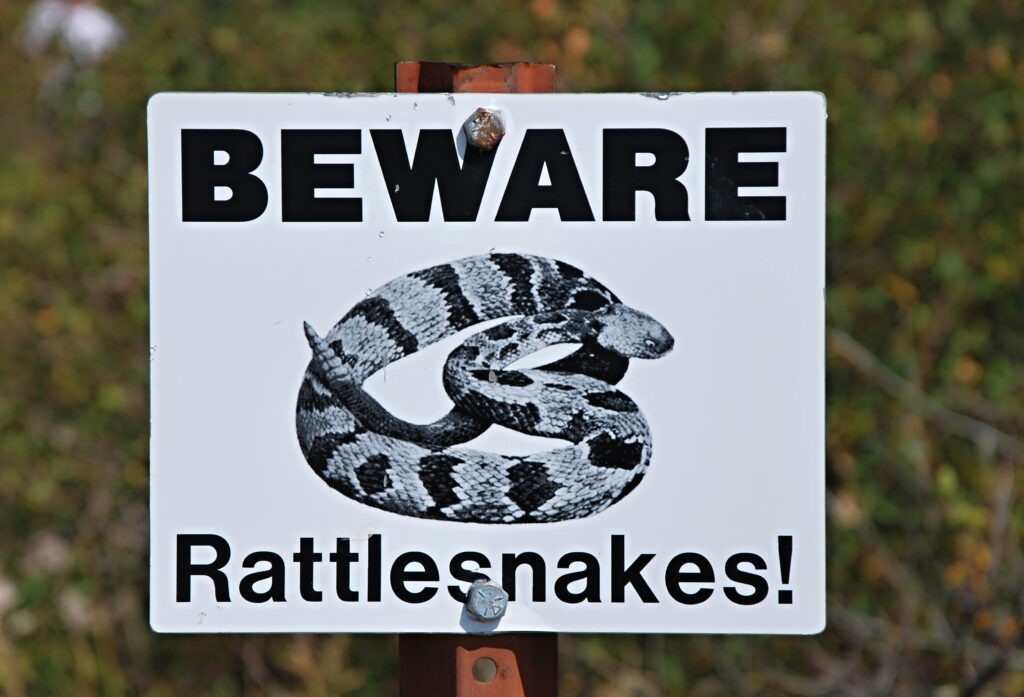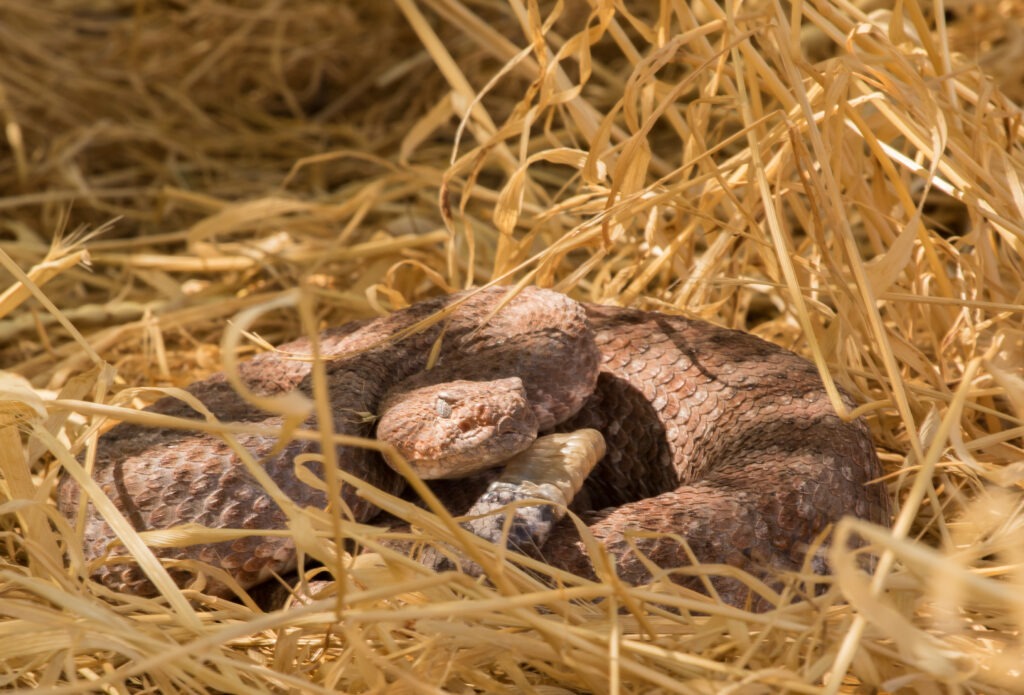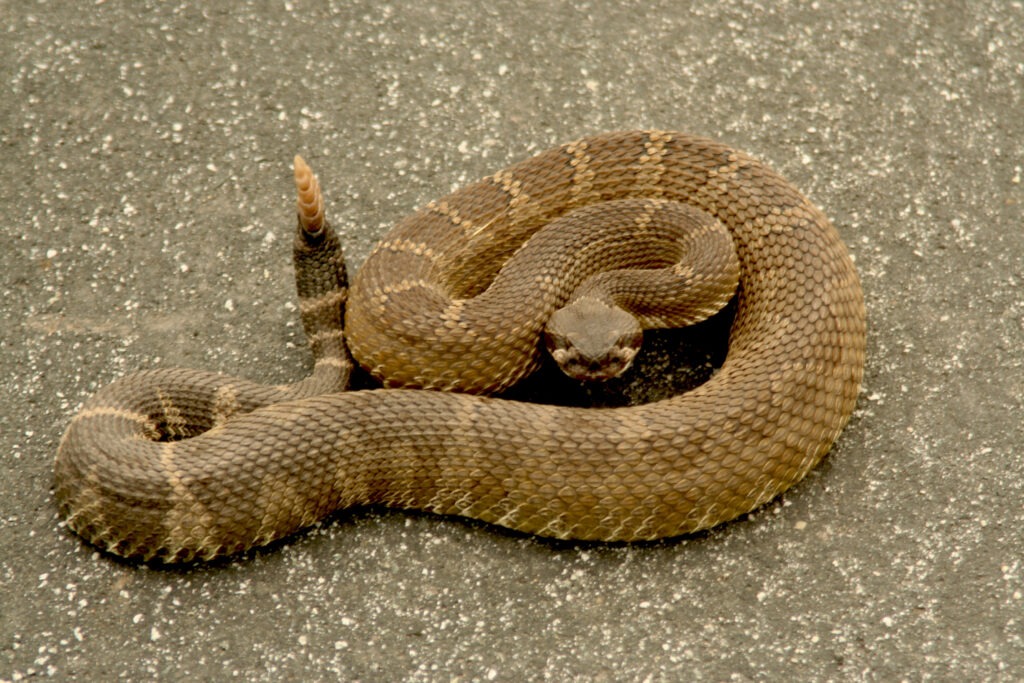
As the weather begins to warm up, hiking trails and outdoor activities become more appealing. What’s not appealing is the possibility of running into a rattlesnake. But where do rattlesnakes like to hang out?
Here’s what I’ve noticed:
Rattlesnakes can be found sunbathing on a warm surface, hiding in tall grass or bushes, in holes, under rocks, or in stacks of wood. They might even seek shelter in empty shoes, tents, barns, or other sheltered buildings as the primary goal is shelter, water, and warmth.
Knowing that rattlesnakes could be anywhere on the trail, where are some common places rattlesnakes enjoy?
Rattlesnake Favorite Places
Rattlesnakes have their favorite places to rest, feast, and slither through. Here is a list of some of those specific places.
Hot Rocks, Concrete, or Pavement
Rattlesnakes are cold-blooded reptiles, which means they love soaking up the heat on a hot summer day. Their metabolism or activity varies greatly depending on the rattlesnake’s temperature. They are more active in the heat and become slow and lazy during cold days and months.
During the warm days and months, rattlesnakes take advantage of the sun and solar energy by bathing on a flat rock, log, or pavement where they can optimize their sun intake. When the cold weather comes around, rattlesnakes warm themselves under leaf litter to stay protected from the cold.
They also will stay in holes or burrows underground.
Fun Fact: Snakes and rattlesnakes are ectothermic which means they are incapable of regulating their own body heat. They depend on their surroundings to provide the heat they need to survive. Due to the lack of heat during the winter, snakes and rattlesnakes are completely inactive. To keep from freezing, they wrap themselves up into a tight ball and stay covered.
Tall Grass

Rattlesnakes can be found in tall grass slithering around or hiding, staying low to the ground. Both are usually in preparation for their next meal. Rattlesnakes’ main source of food is mice and other small rodents. Most of these live in tall grass, which is why you can often find rattlesnakes in the tall grass.
While you are hiking or exploring nature, you should always look before you step, especially if you are walking through tall grass. When going through tall grass, it can be difficult to see the ground to watch out for rattlesnakes.
Keep a listening ear out for the rattlesnakes.
Often if they are feeling threatened they will rattle to warn someone where they are. Unfortunately, they do not always do this. This is why it is so important that you watch before you step to ensure you do not step on a rattlesnake.
Tallgrass is not only found on the trails, when you are attempting to remove snakes from your yard, regularly mowing your yard is one of the best preventative measures for rattlesnakes. During snake season (April-May and September), you should be mowing your yard at least once a week.
The grass will be too short for mice and rodents to hide in and will prevent snakes from wanting to slither through.
Open, Still Water
Rattlesnakes and all snakes absorb liquid through their skin.
In order to get the water they need to survive, they need to go and slither through or soak in it. Especially after recent rainfall, snakes can be found in natural holders of water, open rocks and dips in the hiking trails are some places where they may be found.
Contrary to some opinions out there, rattlesnakes can swim.
They often will swim in open water in search of their next meal or mate. They can also travel across the water to find refuge or escape a predator. When rattlesnakes swim, they stay on top of the water and will do slither-like actions to move across the top of the water.
You may be worried about your pool in your backyard.
The good news is that rattlesnakes try to avoid swimming pools at all costs. The chlorine in the pool is poisonous to not only rattlesnakes but all snakes. If a snake does end up in your pool, it fell in by accident. This should ease some worries you may be having about your backyard swimming pool.
But there’s 1 exception to rattlesnakes and swimming pools. So check out my recent article on that to learn more. Just click that link to read it on my site.
How to Avoid Rattlesnakes and an Attack
Living in areas where rattlesnakes are common, it can be nerve-racking thinking about an encounter with one of these venomous reptiles.
Especially while hiking in nature, there is more of an abundance of all snakes, including rattlesnakes. Although there is no way to prevent every rattlesnake attack, there are some tips and tricks you can follow to prevent unnecessary attacks.
Look where you are stepping.
If you remember nothing from this article but one sentence, it is this. Most rattlesnake bites have happened because the victim stepped on the snake.
I still remember my friend Pér stepping on a rattlesnake at McKinney Falls State Park outside of Austin.
He was walking through grass that was about 2 feet tall, and if I recall correctly, not only was he doing that, but he was looking through binoculars! Low and behold he stepped on one, and it bit him.
Unfortunately for Pér, while the venom didn’t cause him serious injury, the anti-venom medication did and he was hospitalized for quite a while.
Simply watching your step can prevent this from happening to you.
Especially when you encounter a log or large rock which is blocking some of the paths, look on top before climbing or stepping onto, and always look on the landing area where you will next step before landing.
Listening for a rattle is always a great thing to keep in mind when hiking in rattlesnake-infested areas. Rattlesnakes rattle when they feel threatened or scared. But ironically they don’t actually hear sounds the way you and I do.
This is not only an act of self-defense, it is a warning sign that the snake is about to attack. While hiking, if you hear rattles, you should leave the area immediately.
Fun Fact: Rattlesnakes get a new “ring” on their rattle each time they shed their skin.

What Happens if You Get Attacked by a Rattlesnake?
If you get attacked and bitten by a rattlesnake, you should immediately go to the nearest hospital. The best thing to do is to try and stay calm. Try not to walk or put pressure on the affected area.
Although rattlesnakes are venomous, due to current medicine, people rarely die from rattlesnake bites.
If necessary, walk slowly and take many breaks. While receiving proper medical treatment, you will be given antivenin which will stop the venom from killing you.
Although they are rarely fatal to humans, rattlesnake bites are extremely painful. It is best to use all preventative measures to avoid going through a rattlesnake bite.
